Auntie Kearney’s Mid-Century Tavern
Emerging Civil War welcomes guest author Francesca Costa…
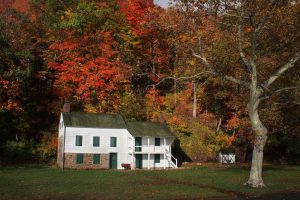
At the Palisades Interstate Park in New Jersey, visitors enjoy hiking trails and kayaking on the Hudson. Every weekend, people are surprised by the historic Kearney House they stumble across, because few places this old survive, and even fewer on such desirable shorelines. While the Kearney House is a Dutch-Colonial dating to around the 1760’s, it would be an easy trap to fall into if we kept our interpretation solely within the Revolutionary Period. Writing a “House Biography” is difficult because each subsequent time-period often complements earlier periods or engages with local conflations of different moments. There are no perfect solutions, but as we explain to hikers, we try to keep the house in the mid-1800’s because we know the most about its role then. We are not only giving our interpretation a focal point, but also resurrecting Rachel Kearney’s dockside Tavern. It is this sweet spot of the 1840’s through 1860’s when the Kearney House was witness to industrialization and growth, encroaching on the boating community. The Civil War touched this network, though battlefields were hundreds of miles to the south. The people living along the Hudson River are remembered in our park, due in large part to the colorful widow who ran a tavern while raising nine children.
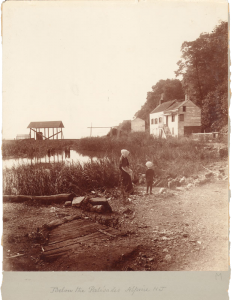
Revolutionary skirmishes occurred close by, but our house has no proven connection to a military encounter. Instead, we prefer to focus on the lives of those who were dwelling along the Hudson River, like the Kearney Family. Even so, this does not erase the impact wars had on the site or surrounding houses. Boatmen read news of the looming Civil War aloud to shipmates and fishermen docked between tides and within the walls of taverns. Each day brought gossip, opinions, as well as news from other areas on the lips of boatmen travelling up and down the waterways. Hudson River supply chains brought wheat from the Erie Canal all the way down to hungry and growing cities. The swift distribution of food by those willing to travel the waterways fed New Jersey and New York home fronts. During a good day, as many as 40 wagon-loads of fresh produce from local farms passed in front of the Kearney House and were loaded onto boats city-bound. Intertidal waters provided an easier sail up or downriver but required waiting for the right current. An ideal location for a place to sell food and drinks!

Library of Congress
The Palisades formation shaped how people used the land along the Hudson, especially the southernmost 15 miles before reaching the tip of Manhattan. On the New York side of the river, hilly but passable terrain facilitated the settlement and growth of New York City, Yonkers, as well as river ports further North. The New Jersey side of the river had but a sliver of land along the shore with stark cliff faces hundreds of feet tall. Physically separated except for periodic breaks in these Palisades, boatmen and their families along the river tended to be hardworking and fiercely loved their local area. According to church-goers on top of the cliffs, the folks along the river were “a rude people, boisterous on Sunday and apt to persecute those who tried to secure the proper observance of that day.” From early on, this multiracial group of riverworkers was composed of free African-Americans, Old Dutch families, and newer immigrants from England and Ireland.
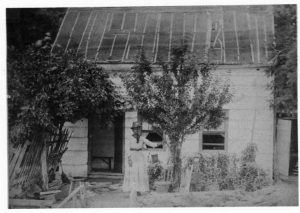
Communities on the river were highly mobile; despite their scrappy reputation, many below the cliffs as in the surrounding farming settlements volunteered for New York or New Jersey Regiments when the Civil War came. Later memories of locals describe them as proud of their river lifestyle, but this independent streak probably didn’t span to larger state loyalties. The closest town for many was a boat ride across the river to New York State rather than scaling the cliffs and venturing further into New Jersey. The NJ/NY state line lies only about 6 miles north of the Kearney House, and trips downriver to New York City were part of the local boatman’s regular work life, so when enlisting these boys and men signed up with New York and New Jersey regiments alike. Despite these commitments, ferrymen and fishers seemed to be fickle soldiers. A group of local boys joined the 6th NY Cavalry (“The Second Ira Harris Gaurd”), where some deserted and ran home. After that, many who ran away signed up with the 22nd NJ Volunteer Infantry (their local regiment), deserted again, and in at least one case, were chased down to finish their first Calvary services.
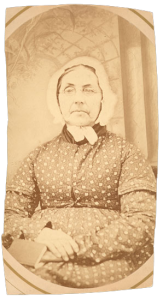
The Kearney family’s own Civil War tragedy remains the most personal impact of the Civil War upon our current interpretation of the site. “Auntie Kearney” ran a welcoming tavern where boatmen enjoyed company and dried off before the tides changed. More like an inn today than a bar, it was a safe place for both locals and travelers from further upstate to eat, drink, and even spend the night. In the summer of 1862, like the others, Rachel’s grandson Charles Conklin enlisted. His father had recently died, leaving a mother and her children living at the tavern with Rachel. Possibly because he was the eldest, and possibly to get more money to feed the family he left behind, Charles Conklin left with the 133rd Regiment of New York Infantry (“The Metropolitan Guard”) and was shipped down to Louisiana.
During a Union assault on Port Hudson in May 1863, Charles was struck by a bullet in the left shoulder. He was taken to New Orleans, where he died in mid-June. His mother, Ellen Conklin, received a pension of $8 per month until her own death in 1909. Rachel Kearney raised at least 9 children during her 90 years of life and represented the Dutch-Americans who colonized the NJ/NY area. She saw over fifty grandchildren come into the world, but Charles Conklin left a painful absence at the tavern. Emotions would be high in the Kearney tavern as daily headlines were read aloud. By the end of the war, the communities along the Hudson River were forever changed.
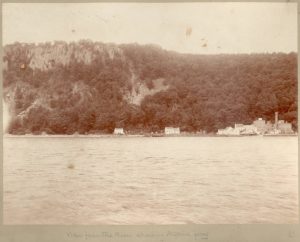
Although we cannot attest to anyone’s politics, the ferrymen and fishermen along the river were living relatively unsegregated lives, and later accounts of drinking parties note multiracial residents sharing the same boats on trips to Yonkers Saloons. Once 1863 rolled around, free Black members of Bergen County joined the ranks like their neighbors.
With the sorrow that the Civil War brought to these riverside villages, there was joy to be found in daily life and the gaiety any tavern would know. Today, when the Kearney House is illuminated by candlelight and we entertain guests with songs and drink, we try to pay homage to the resilient people living on the shores of the Hudson.
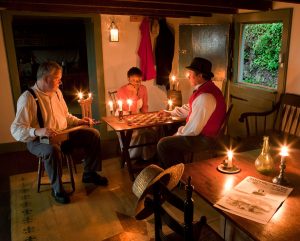
This piece was submitted by Francesca Costa, Historic Interpreter at the Palisades Interstate Park in New Jersey. Since its foundation in 1900, the PIP has helped to preserve historic landmarks and protect the natural landscape and shoreline of the Hudson River. Today’s park system maintains more than 100,000 acres of wilderness and 9 historic sites.
On to NJ for a visit, soonest!!!! Great item….
Happy exploring!
This is some great local history about a US homefront community. Looking forward to seeing the park someday!
Thanks so much! Enjoy
I live only a few miles away and am excited to visit. See you there!!
Come on down on the weekends and we will be happy to talk to you about all sorts of history!
Thank you so much for writing this. It wasn’t so easy to find information on Kearny homestead and tavern. Very much appreciated. Wish there was more info. Is there any way to get there now with the road being closed?